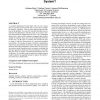Free Online Productivity Tools
i2Speak
i2Symbol
i2OCR
iTex2Img
iWeb2Print
iWeb2Shot
i2Type
iPdf2Split
iPdf2Merge
i2Bopomofo
i2Arabic
i2Style
i2Image
i2PDF
iLatex2Rtf
Sci2ools
IUI
2004
ACM
2004
ACM
What role can adaptive support play in an adaptable system?
As computer applications become larger with every new version, there is a growing need to provide some way for users to manage the interface complexity. There are three different potential solutions to this problem: 1) an adaptable interface that allows users to customize the application to suit their needs; 2) an adaptive interface that performs the adaptation for the users; or 3) a combination of the adaptive and adaptable solutions, an approach that would be suitable in situations where users are not customizing effectively on their own. In this paper we examine what it means for users to engage in effective customization of a menu-based graphical user interface. We examine one aspect of effective customization, which is how characteristics of the users’ tasks and customization behaviour affect their performance on those tasks. We do so by using a process model simulation based on cognitive modelling that generates quantitative predictions of user performance. Our results show th...
Adaptable Interfaces | Customization Behaviours | Effective Customization | IUI 2004 | Software Engineering |
| Added | 30 Jun 2010 |
| Updated | 30 Jun 2010 |
| Type | Conference |
| Year | 2004 |
| Where | IUI |
| Authors | Andrea Bunt, Cristina Conati, Joanna McGrenere |
Comments (0)

